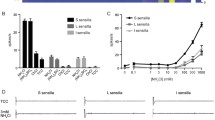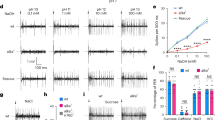Abstract
ANALYSIS of mutant organisms can elucidate by contrast the development of the normal phenotype and this approach can be used to break down behavioural characteristics into their embryological and physiological components. Taste in insects is a characteristic suitable for such a study. Genetic analysis of taste in Drosophila melanogaster can complement the electrophysiological and anatomical information on taste organs of flies obtained mainly from Calliphora and Phormia. The taste organs of flies are located predominantly on the labella at the tip of the proboscis, and on the tarsi. On each half labellum of Drosophila there are 36–42 taste bristles on the surface and some 25 taste pegs between the pseudotracheae. All but five or six bristles are penetrated by the dendrites of four chemoreceptors (the remaining ones having two dendrites), while there is only one chemoreceptor in each interpseudotracheal peg. Each taste organ is also provided with a mechano-receptor neurone (R. F., Bleiser-Avivi and J. A., in preparation). Of the four dendrites penetrating to the pore at the tip of the taste bristles in Phormia1–3, one is a water sensor, one reacts to sugars and two react to salts4–6.
Similar content being viewed by others
References
Hansen, K., and Heumann, H. G., Z. Zellforsch. Mikrosk. Anat., 117, 419–442 (1971).
Slifer, E. H., Int. Rev. Entomol., 15, 121–142 (1970).
Sturckow, B., Holbert, P. E., and Adams, J. R., Experientia, 23, 780–782 (1967).
Dethier, V. G., Q. Rev. Biol., 30, 348–371 (1955); Science, 161, 389–391 (1968).
Evans, D. R., and Mellon Jr, D., J. gen. Physiol., 45, 487–500 (1962); 45, 651–661 (1962).
McCutchan, M. C., J. Insect Physiol., 15, 2059–2068 (1969).
Genesis, 19 v26.
Atidia, J., and Falk, R., Fourth Eur. Drosophila Res. Conf., Umea (1974).
Getting, P. A., and Steinhardt, R. A., J. Insect Physiol., 18, 1673–1681 (1972).
Lindsley, D. L., and Grell, E. H. Genetic Variations of Drosophila melanogaster (Carnegie Institute, Washington Publ., 627, 1968).
Garcia-Bellido, A., and Merriam, J. R., J. exp. Zool., 170, 61–67 (1969).
Hotta, Y., and Benzer, S., Nature, 240, 527–535 (1972).
Merriam, J. R., and Lange, K., Devl Biol., 38, 196–201 (1974).
Author information
Authors and Affiliations
Rights and permissions
About this article
Cite this article
FALK, R., ATIDIA, J. Mutation affecting taste perception in Drosophila melanogaster. Nature 254, 325–326 (1975). https://doi.org/10.1038/254325a0
Received:
Issue Date:
DOI: https://doi.org/10.1038/254325a0
- Springer Nature Limited
This article is cited by
-
10.1007/BF00343500
CrossRef Listing of Deleted DOIs (2011)
-
Gust J, a salt-insensitive mutant ofDrosophila melanogaster
Journal of Genetics (1997)
-
Differences among sibling speciesRhagoletis mendax andR. pomonella (diptera: ephritidae) in their antennal sensitivity to host fruit compounds
Journal of Chemical Ecology (1992)
-
Closely linked lesions in a region of the X chromosome affect central and peripheral steps in gustatory processing in Drosophila
Molecular and General Genetics MGG (1991)
-
Isolation and characterization of feeding behavior mutants inDrosophila melanogaster
Behavior Genetics (1990)





